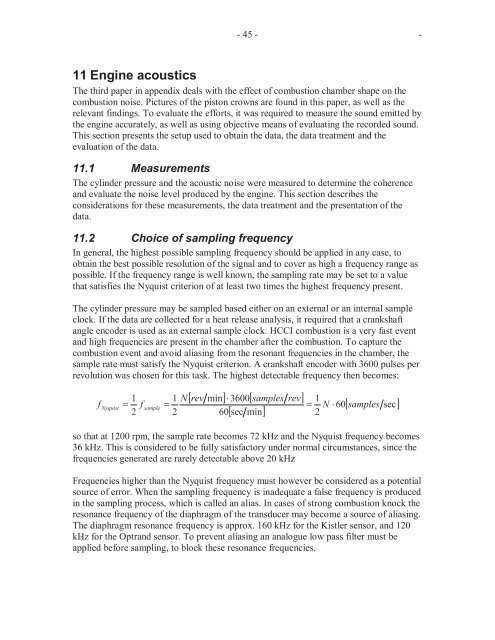Troels Dyhr Pedersen.indd - Solid Mechanics
Troels Dyhr Pedersen.indd - Solid Mechanics
Troels Dyhr Pedersen.indd - Solid Mechanics
You also want an ePaper? Increase the reach of your titles
YUMPU automatically turns print PDFs into web optimized ePapers that Google loves.
- 45 - -<br />
11 Engine acoustics<br />
The third paper in appendix deals with the effect of combustion chamber shape on the<br />
combustion noise. Pictures of the piston crowns are found in this paper, as well as the<br />
relevant findings. To evaluate the efforts, it was required to measure the sound emitted by<br />
the engine accurately, as well as using objective means of evaluating the recorded sound.<br />
This section presents the setup used to obtain the data, the data treatment and the<br />
evaluation of the data.<br />
11.1 Measurements<br />
The cylinder pressure and the acoustic noise were measured to determine the coherence<br />
and evaluate the noise level produced by the engine. This section describes the<br />
considerations for these measurements, the data treatment and the presentation of the<br />
data.<br />
11.2 Choice of sampling frequency<br />
In general, the highest possible sampling frequency should be applied in any case, to<br />
obtain the best possible resolution of the signal and to cover as high a frequency range as<br />
possible. If the frequency range is well known, the sampling rate may be set to a value<br />
that satisfies the Nyquist criterion of at least two times the highest frequency present.<br />
The cylinder pressure may be sampled based either on an external or an internal sample<br />
clock. If the data are collected for a heat release analysis, it required that a crankshaft<br />
angle encoder is used as an external sample clock. HCCI combustion is a very fast event<br />
and high frequencies are present in the chamber after the combustion. To capture the<br />
combustion event and avoid aliasing from the resonant frequencies in the chamber, the<br />
sample rate must satisfy the Nyquist criterion. A crankshaft encoder with 3600 pulses per<br />
revolution was chosen for this task. The highest detectable frequency then becomes:<br />
1<br />
= f<br />
2<br />
f Nyquist sample<br />
=<br />
1<br />
2<br />
N<br />
[ rev min]<br />
⋅ 3600[<br />
samples rev]<br />
60[<br />
sec min]<br />
1<br />
= N ⋅ 60<br />
2<br />
[ samples sec]<br />
so that at 1200 rpm, the sample rate becomes 72 kHz and the Nyquist frequency becomes<br />
36 kHz. This is considered to be fully satisfactory under normal circumstances, since the<br />
frequencies generated are rarely detectable above 20 kHz<br />
Frequencies higher than the Nyquist frequency must however be considered as a potential<br />
source of error. When the sampling frequency is inadequate a false frequency is produced<br />
in the sampling process, which is called an alias. In cases of strong combustion knock the<br />
resonance frequency of the diaphragm of the transducer may become a source of aliasing.<br />
The diaphragm resonance frequency is approx. 160 kHz for the Kistler sensor, and 120<br />
kHz for the Optrand sensor. To prevent aliasing an analogue low pass filter must be<br />
applied before sampling, to block these resonance frequencies.

















